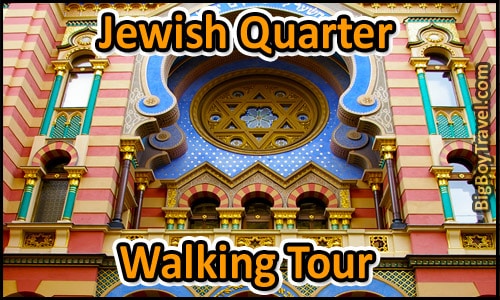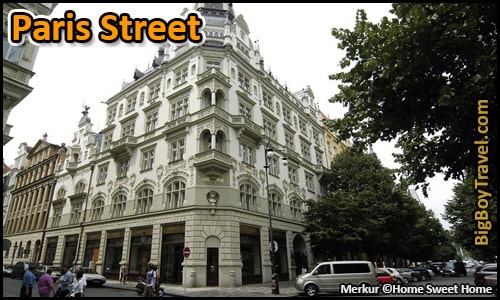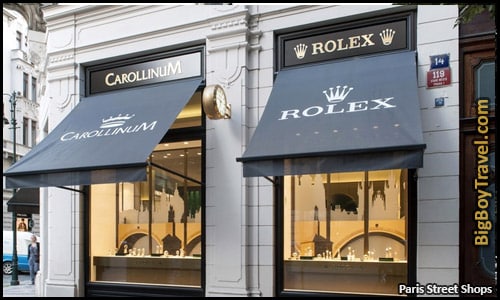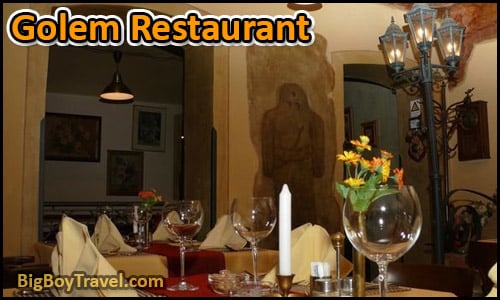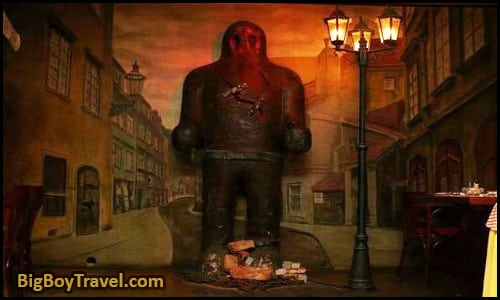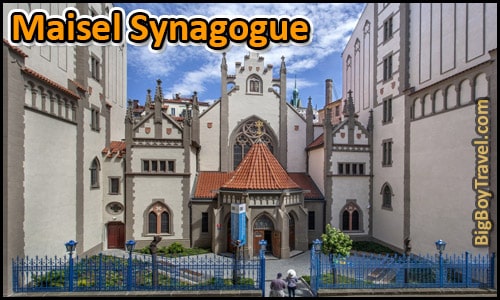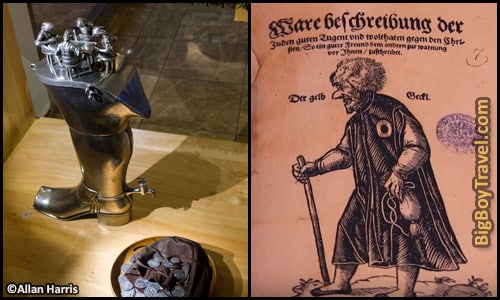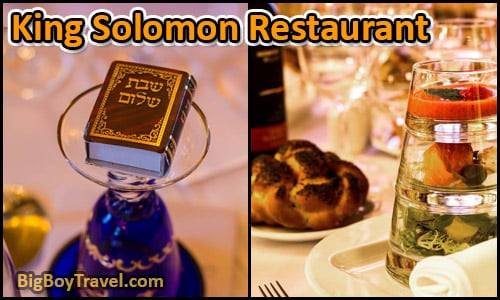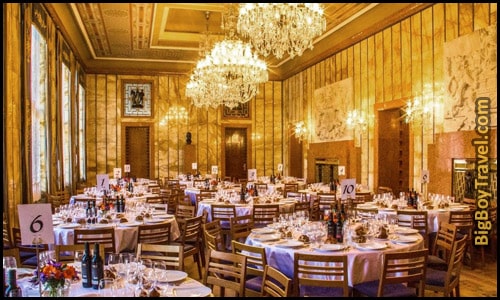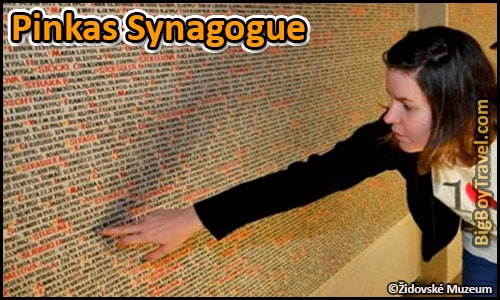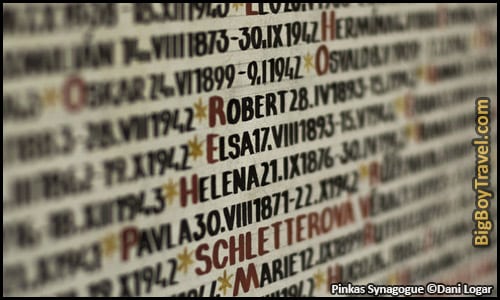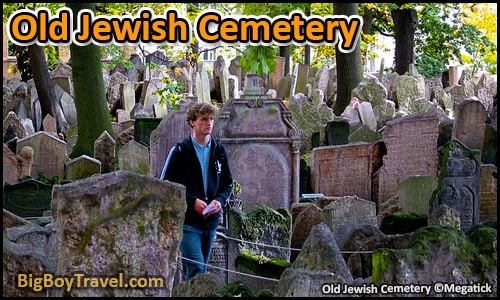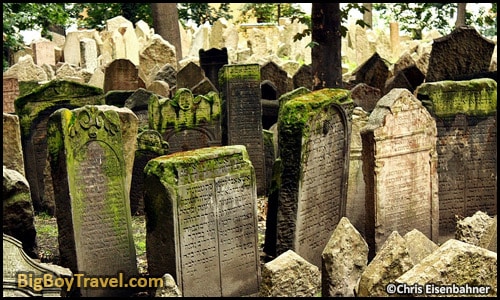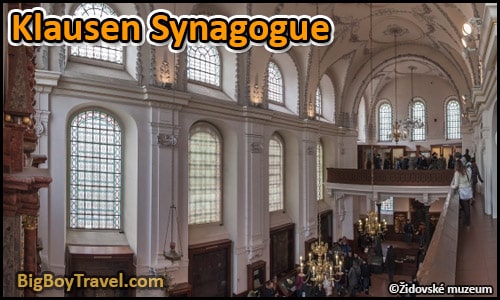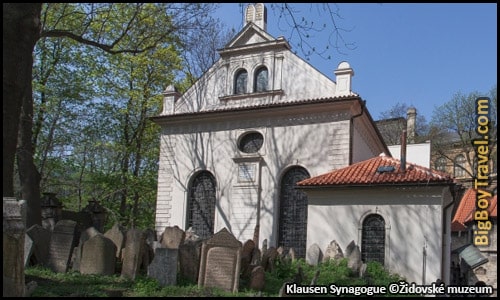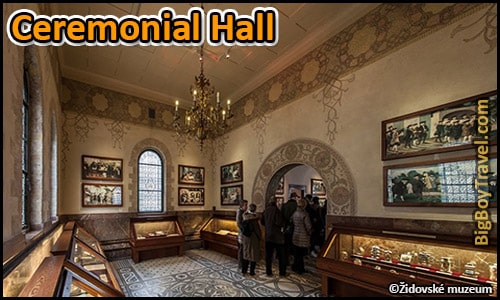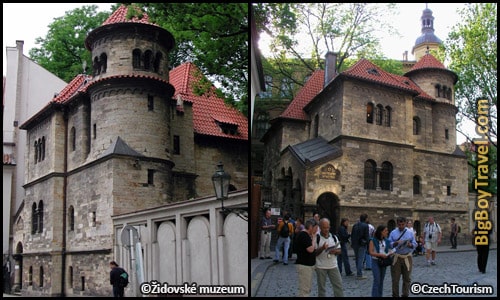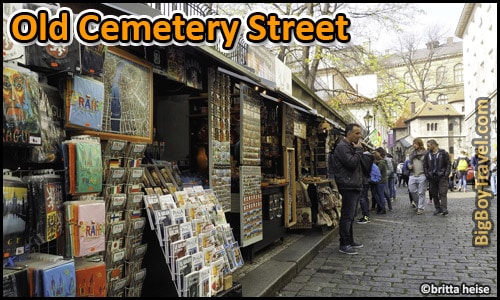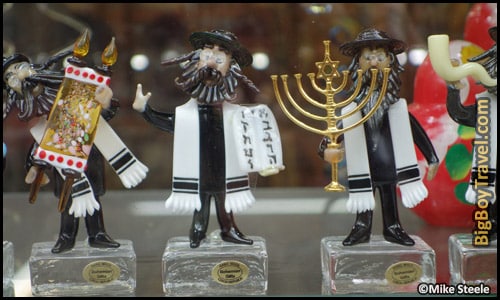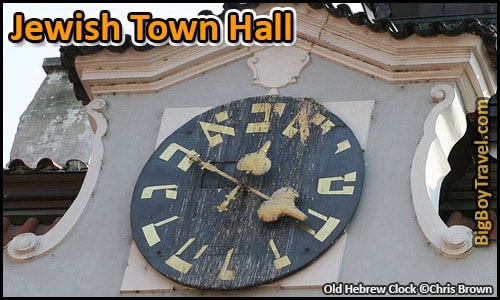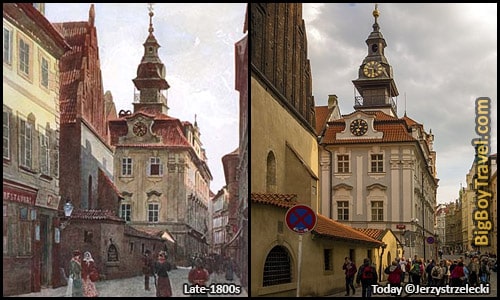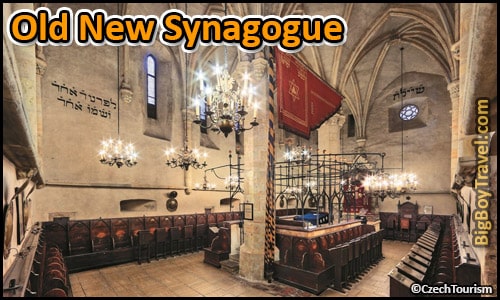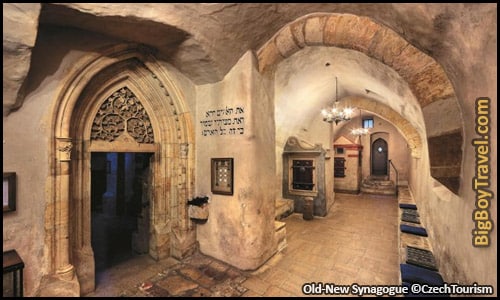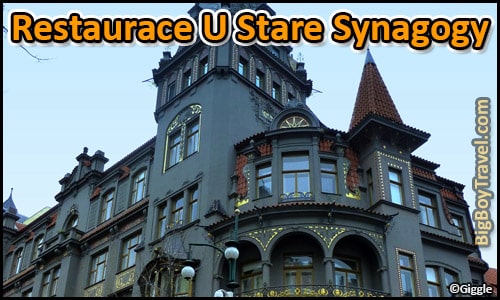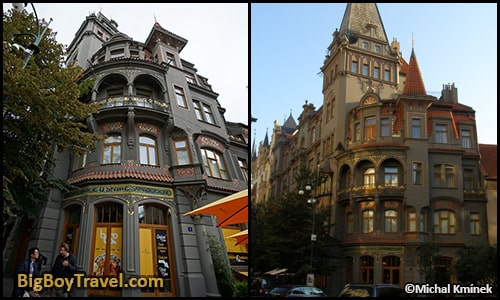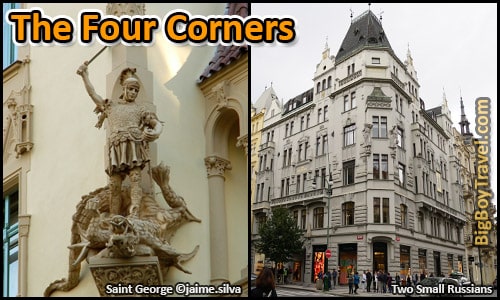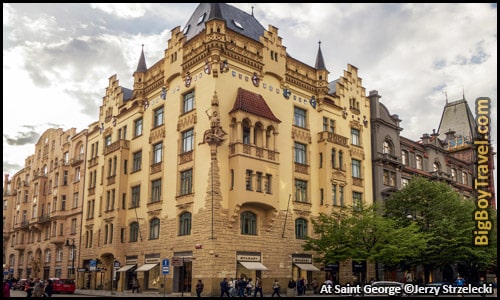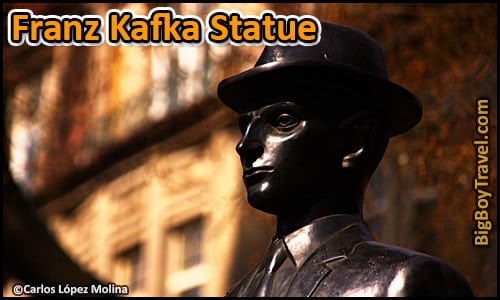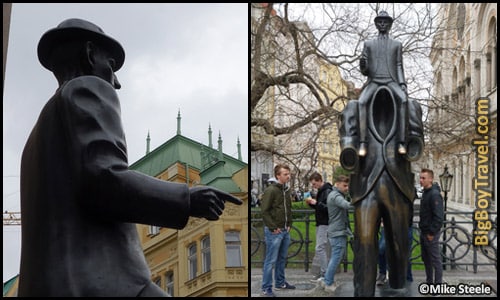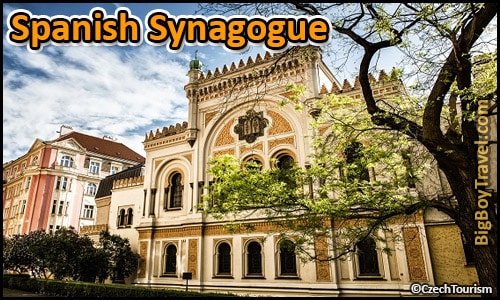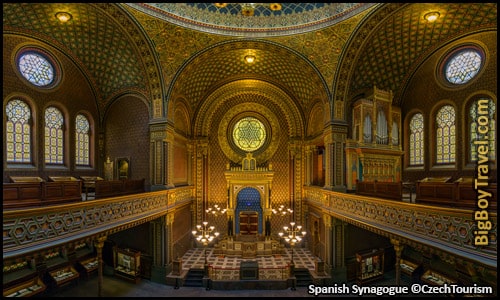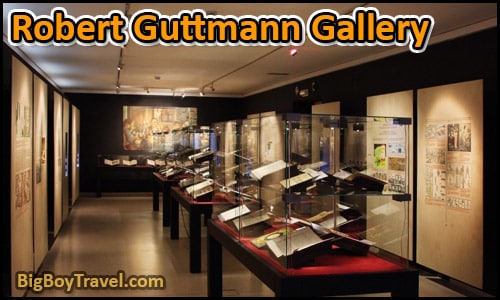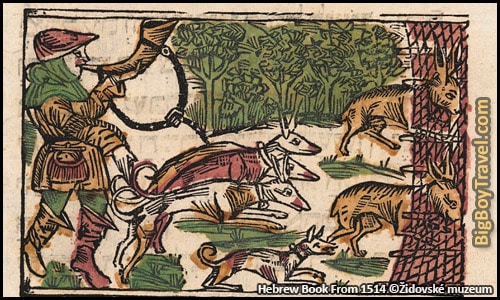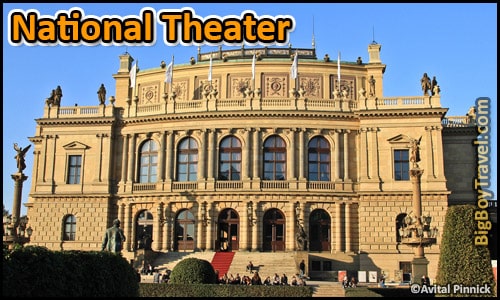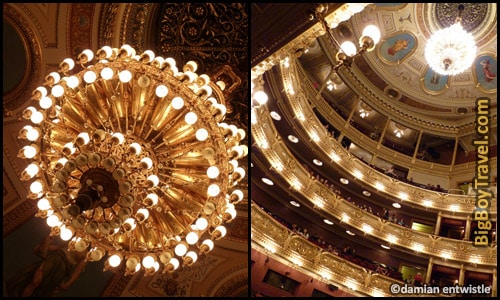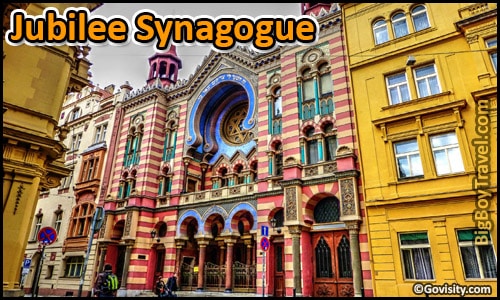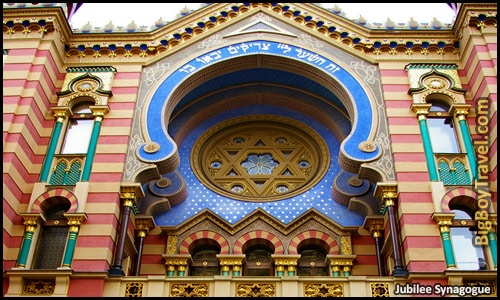Jewish Quarter Walking Tour:
Location: Prague’s Jewish Quarter (Josefov)
Cost: Free (optional costs below)
Style: Self-guided walking tour
Start: Pařížská Street
End: Old Town Square
Note: Jewish synagogues are closed on Saturdays
Walking Distance: 0.85 miles
Time: 30 minutes for the walk (with sights 3-4 hours)
Fun Scale: 9 out of 10
Jewish Quarter Overview:
Bordering the Northside of Old Town, the Jewish Quarter is one of the most historic places to visit in Prague. The former Jewish Ghetto has been inhabited for over one thousand years, grew to be self-governing, and once made up 25% of Prague’s population. Through re-developing at the turn of the 20th century and the atrocities of WW2 most of the medieval homes and tens of thousands of residents are gone forever but the Jewish Quarter lives on. Among the sights on this tour, you’ll find Europe’s oldest synagogue, collections of priceless artifacts, a timeless cemetery, kosher restaurants, plenty of history, and insight into local Jewish culture. We hope you enjoy our Prague Jewish Quarter Walking Tour!
History of Prague’s Jewish Quarter:
Jewish people have been living in Prague since as early as 970 AD, but have walked a tough road to gain acceptance and safety. At first, the Jewish community grew on both sides of Vlata (Moldau) River with most of the development below Prague Castle. During the 1st Crusade in 1096, the Jewish population in Prague first started to face violent opposition from Christian groups and they were ravaged during the Siege of Prague Castle in 1142. To gain a safe foothold in the Prague, the Jewish community began to consolidate in the right bank of the river forming the Jewish Quarter later known as the Ghetto.
The Jewish Quarter provided a much safety net and King Otakar II gave them rights to administer themselves in 1262, although the residents had limited rights. The population quickly grew to over 3,000 but then during the assault on Easter Sunday, 1389 over half of the Jewish Quarter’s residents were murdered by a mob. It was a rough time and the Jewish Quarter had its gates locked at night by the city and residents weren’t allowed to leave after dark.
In the 1500s, the Jewish Quarter finally started to hit its Golden Age when Jewish Mayor Mordechai Maisel was elected Prague’s Minister of Finance. Maisel’s election not only helped to give the Jewish quarter a voice, but also helped them get much-needed financing for development. These developments included paving the Jewish Quarter’s streets to building many new Synagogues and the Jewish Town Hall. The growth was tremendous as the Jewish community quickly double to 10% of Prague’s population with 7,000 people.
This Golden Age ended abruptly 200 years later when Austro-Hungarian Empress Maria Theresa expelled the Jews from Prague in 1745. When Empress Maria Theresa’s son Joseph II took over he became the Holy Roman Emperor you would think life would get even harder for Prague’s Jews, but the opposite happened. Joseph II led a large number of reforms throughout Christendom that helped to improve the lives of European Jews by officially recognizing their religion. They were allowed to come back to Prague’s Jewish Quarter and had the restrictions of their movements lifted. The Jewish Quarter was even able to shed its Ghetto status and became an official district of Prague. Because of his these reforms, the Jewish Quarter became known as Josefov in Emperor Joseph II’s honor after it was annexed into Old Town 1850.
The darkest time for Prague’s Jewish Quarter came when the Nazis occupation started in 1939. Within a year of the Nazis seizing power, most Jewish businesses were confiscated and public life became segregated. Jewish citizens were restricted to the Ghetto, and thousands were deported. Most of the deportations either involved sending people to other Ghettos in Nazi-controlled areas to split up families or by sending people directly to death camps. Before WW2 Prague’s Jewish population had grown to 25% of the city’s population and had the largest numbers of Jewish residents of in any city in the world with over 90,000. During the Holocaust, it is estimated that nearly 70% of the 100,000 Jewish people “deported” from greater Prague during the war died. In total over 250,000 Jewish people who lived in Czech Lands before 1938 were killed under Nazi rule.
With all who died, luckily numerous groups of Jewish children in Prague were rescued during the war through a secret British adoption ring run by Nicholas Winton. Also during those hellish days, many Jewish artifacts were hidden from the Nazis and had been preserved for future generations. We touch on these and many more interesting things below in our Jewish Quarter walking tour. After being liberated in from the Nazis, the Jewish Quarter in Prague still had struggles under Communist rule (1948-1989). Of the 15,000 Jewish people who returned to Prague after the war 50% fled Communist oppression to Israel. Today only 5,000 Jewish people remain in Prague, but the Jewish Quarter has slowly recovered to become a vibrant and delightful neighborhood to visit.
Jewish Quarter Walking Tour:
1. Paris Street (Pařížská):
About Pařížská Street: Connecting Prague’s the with Old Town Square with the Jewish Quarter, Paris (Pařížská) Street has high-end shopping that rivals the Champs-Élysées in Paris and 5th Avenue in New York City. This tree-lined shopping paradise has everything from Prada, Louis Vuitton, Burberry, Swarovski, and more to get your high fashion on. We love how the greenery makes this street feel so peaceful compared to other shopping areas that are more chaotic.
Originally this boulevard was called Mikulasska Street (photo) and was filled with tightly packed Medieval homes. After the Jewish Quarter became part of Old Town Prague in 1850 controversial re-development started and the neighborhood. From 1893-1914 many of the small historic Jew Quarter homes were demolished for huge fancy buildings leaving only some of the more significant Jewish monuments standing. The huge buildings that sprung along Pařížská Street slowly became attractive to locals thanks to the use of eclectic design styles ranging from neo-Baroque to Art Nouveau with mixes of Gothic elements.
From 1897-1914 a number of huge attractive buildings sprung up on the new Pařížská Street in eclectic styles ranging from neo-Baroque to Art Nouveau. The changes started right on the edge of Prague’s Old Town Square when the 3-story-tall Krenn House (built in 1409, photo) was torn down in 1901 opening up views of large Church of Saint Nicolas. At the opening of the shopping street, the Neo-Baroque mansion called the Schier’s House (Pařížská 1) was built by Rudolf Krizenecky who was an architect and professor at the Technical University. The white mansion you see today had a large corner tower (photo), but it was lost from a fire in WW2.
As you reach the first intersection of Pařížská Street three corner houses were designed by local architect Jan Vejrych. He was influential to Prague’s architecture by combining the Art Nouveau style with Medieval and Renaissance elements. The massive Mer-Kur building (Pařížská 9) housing the Gucci store is the most interesting of these buildings as it has motifs depicting different trade professions.
Theater Cost: 480 CZK. Theater Hours: Shows are typically at 8pm but they sometimes add a second performance at 6pm. Address: Pařížská 4. Theater Website: (HERE).
2. Golem Restaurant (U Golema):
About Golema Restaurant: At the first cross-street on Pařížská Street, take a left and in a short block you’ll be at the historic Golema Restaurant which opened in 1967. This themed restaurant is based on the fabled Golem created by Rabbi Yehudi Loew in the early 1600s to protect the Jewish Quarter from anti-Semitic attacks. It’s said that the Rabbi molded the Golem out of clay from the banks of Prague’s Vltava River then brought it to life through rituals and Hebrew incantations. It’s said that the body of the golem is stored in the attic of the Old New Synagogue ready to be restored back to life again if needed.
Images of the Golem can be found in the design of the cobblestone in front of the restaurant and the playful sign on the door. The food is only okay, but the decor creates intrigue with street lamps, Golem figures, and exposed brick that helps give it an old-world feel.
Address: Maiselova 62/8. Hours: Daily 10am-8:30pm. Restaurant Website: (HERE).
3. Maisel Synagogue & Jewish Museum:
About The Maisel Synagogue: In the late-1500s, wealthy resident Mordechai Maisel became Mayor of the Jewish community and gained a lot of influence when he was appointed Minister of Finance for Holy Roman Emperor Rudolf II’s royal court. Using this influence, Maisel was able to profit off loans to the King and invest in the neighborhood he represented to help revive it. His renovations spread to buildings such as the Town Hall in 1586 and even to many streets themselves which can still be seen today. These works helped the Jewish community grow into its golden age and also made Maisel a revered leader in Prague. He even used his position to loan money to Emperor Rudolf II for his battles with the Turks which made Maisel one of the richest people in Prague.
With his newfound wealth, Mayor Mordechai Maisel had a Synagogue built here in 1592 as a private place of worship for his family which still bears his name. The family really wanted their Synagogue to be immaculate they filled it with a wealth of gold and silver which has been lost over time. Originally built as a Renaissance temple, the Maisel Synagogue has been rebuilt twice due to fire with the biggest one being in 1689.
Since 1995 the Maisel Synagogue has been part of Prague’s Jewish Museum celebrating the heritage of Jews in Bohemia and Moravia from the 900s through the 1800s. The Jewish Museum carries over exhibits for the period between the late-1800s until 1945 in the Spanish Synagogue which we will see later on this Jewish Quarter walking tour. The ticket that you buy to enter the Maisel Synagogue also covers most of the rest of the sights on this Jewish Quarter tour with only the Old New Synagogue needing a supplemental ticket.
Hours: Sunday-Friday 9am-6pm; closed at 4:30pm November-March; Closed Saturdays for the Jewish Sabbath. Cost: 530 CZK for Adults; Children 6-15 & students under 26 are 370 CZK; Kids under 6 are free. Entrance fee covers all 5 Jewish Museum Synagogues (Old New Synagogue is an extra 220 CZK), the Old Jewish Cemetery, Ceremonial Hall, and Robert Guttmann Gallery. Address: Maiselova 62/8. Website: (HERE).
4. Jewish Education & Cultural Center:
About The Education & Cultural Center: The Education and Cultural Center is often overlooked by most tourists, but is a great resource for the more scholarly of you. It contains detailed manuscripts with information on Judaism with a focus on the history of Jewish people of Bohemia and Moravia. The Cultural Center is a great addition in the Jewish Quarter, especially for local youth, as the teaching of local history and customs was great suppressed through Nazi and Soviet rule. Symbolically the Cultural Center opened in 1996 on the 90th anniversary of the Jewish Museum’s founding.
Sitting below the Cultural Center is the Information Office for the Jewish Museum. They sell tickets to the local sights, can answer any questions you have about the history, and can put you in touch with in-person guides and events. While the office is a good resource, you would have already bought your Museum ticket at Maisel Synagogue following our suggested route for the self-guide Jewish Quarter walking tour.
Hours: Sunday-Friday 9am-4:30pm; stays open until 6pm April-October; Closed Saturdays for the Jewish Sabbath. Cost: Typically Free; 2-4 day seminars available at an additional cost.
5. King Solomon Restaurant:
About King Solomon Restaurant: King Solomon Restaurant truly is king when it comes to Kosher Restaurants in Prague. They are a little bit pricier than most of the tourist restaurants, but it is the only way to get the truly traditional Jewish experience. SHALOM Kosher Restaurant (website) inside the Jewish Town Hall may be the most popular Kosher Restaurant in the Quarter, but King Solomon’s has a little more high-end food. King Solomon has some great meat fillets and dishes not to mention a pretty solid wine selection.
Hours: Sunday-Thursday Noon-11pm; Friday opens at Noon but Dinner is by reservation only; Saturdays only open for Lunch by reservation. Cost: Best deal is the 3-course meal for 550 CZK. Facebook Page: (HERE). Restaurant Website: (HERE).
6. Pinkas Synagogue (Pinkasova Synagoga):
About Pinkas Synagogue: The small, house-like Pinkas Synagogue first opened as a private place of worship for the family of the wealthy Aron Horowitz in 1535. As Prague’s second oldest surviving Synagogue, it was named after Aron’s grandson Pinkas Horowitz and has become a very powerful place to visit as a tourist.
ost of the emotion from visiting Pinkas comes from the nearly 77,297 names inscribed on the walls of Jews from Bohemia and Moravia that were sent to die in concentration camps by the Nazis in WW2. The staggering number of nearly 80,000 names followed are by their birthdays and last known day they were alive. Because the names are pretty much in alphabetical order by their last name, you can see that many families were all killed on the same day, likely by gas chambers.
It is sad and emotional when the scale of all 77,297 names hit your eyes from every corner of the Synagogue’s interior, but it is an important reminder of the past. Making the experience even more powerful is the fact that the names are read out loud in between religious singing over the speakers. If you are wondering why the names on the ceiling are so much more faded than the walls it is because the ceilings are original and the walls had to be re-written in 1992 after being taken down during closure (1968-1989) under Soviet rule and again from flooding in 2002. When the post-Soviet restoration started, Pinkas formally joined the Jewish Museum which had been established in 1906.
Maybe even more emotional then the names of the victims are touring the drawings and finger paintings in the Children’s Art Exhibit. The art in the Exhibit was made by children in the Terezín Labor Camp from 1942-1944 under the direction of teacher Mrs. Friedl Dicker. Before being sent to her death at the Auschwitz Concentration Camp, Dicker hid 4,500 of the works of art in her luggage which was later found and moved to Pinkas. It’s powerful to know that only 120 of the children involved survived as most were sent from Terezín to the gas chambers in Auschwitz shortly after making this art.
Hours: Sunday-Friday 9am-6pm; closed at 4:30pm November-March; Closed Saturdays for the Jewish Sabbath. Cost: 530 CZK for Adults; Children 6-15 & students under 26 are 370 CZK; Kids under 6 are free. Entrance fee covers all 5 Jewish Museum Synagogues (Old New Synagogue is an extra 220 CZK), the Old Jewish Cemetery, Ceremonial Hall, and Robert Guttmann Gallery. Website: Here.
7. Old Jewish Cemetery (Starý Židovský Hřbitov):
About The Old Jewish Cemetery: After the Jewish Garden (just South of Old Town Prague) was closed by King Vladislaus II in 1478, the Old Jewish Cemetery was the only place Prague’s Jews were allowed to bury their dead until 1787. The oldest grave dates back to 1439 (scholar and poet Avigdor Kara), and a season of tombs with gnarled headstones spreads out in every direction.
Over 350 years the Old Jewish Cemetery with room for 1,200 plots, found itself with 12,000 headstones and up to an astonishing 100,000 estimated buried bodies. Because Jewish traditions saw not to move bodies after they are buried, they literally had to pile new layers of dirt over the old tombs to make more room. In some places, the places are said to be 10 bodies deep and the settling of the ground over time has created tilted tombstones beautifully pointing in every direction. Centuries over capacity, the Old Jewish Cemetery was closed for burials in 1787 after reforms by Joseph II (whom Josefov is named after) allowed for a new cemetery in the suburb of Žižkov.
Because of its tangled headstones, the Old Jewish Cemetery is one of our favorite places in Prague to take photos. While the color and type of stone each headstone is made out of indicates what era it is from, they also have symbols with hidden meaning. Obviously, many of the tombs are marked with the Jewish Star of David, but some have other symbols telling you they either highly respected or a Rabbi. You may even notice loose stones placed on the tops of the headstones which are in homage to the days in early Jewish history where bodies buried in swallow desert sand were layered in rocks to keep them covered. People often ask for wishes when placing peddles on the headstones, but you must bring them to the cemetery from your home or it’s bad luck. Because the Jewish community views cemeteries as gateways to the afterlife, small notes with prayers are also left under these loose stones and in cracks in the cemetery’s walls.
It is kind of strange to find a pre-WWII Jewish Cemetery still surviving in a country once heavily occupied by the Nazis as they would often rip the headstone out to use them for shooting practice. Hitler grew found of Prague’s Jewish Cemetery and decided to leave it untouched, not out of endearment, but because he wanted it to served as a reminder of the extinct race after he killed all of the Jews. Hitler really was a sick man, but in this case, his twisted mind left the headstones for us to admire in peace today. Among the most famous headstones is Rabbi and scholar Avigdor Karo (1439) who has the oldest grave, Mordechai Maisel (1601) the Mayor of the Jewish neighborhood who helped spur development, and Rabbi Loew (1609) who is attached to the legend of the Golem explained later on this Jewish Quarter walking tour.
Hours: Sunday-Friday 9am-6pm; closed at 4:30pm November-March; Closed Saturdays for the Jewish Sabbath. Cost: 530 CZK for Adults; Children 6-15 & students under 26 are 370 CZK; Kids under 6 are free. Entrance fee covers all 5 Jewish Museum Synagogues (Old New Synagogue is an extra 220 CZK), the Old Jewish Cemetery, Ceremonial Hall, and Robert Guttmann Gallery. There aren’t any good free viewpoints to really take in the Cemetery. Website: Here.
8. Klausen Synagogue (Klausová Synagoga):
About The Klausen Synagogue: The Klausen Synagogue was built as a prayer house, bathhouse, and hospital in 1604 in honor of a visit to the Jewish Quarter by Emperor Maximilian II. Although it was the 2nd largest Synagogue at the time in the Jewish neighborhood, it was given the name Klaus (meaning small in German), because it was smaller than the recently built Maisel Synagogue. It may seem weird that the synagogue has a German name, but local Jewish residents often spoke German as their second language behind Hebrew instead of Czech since they weren’t fully integrated into Prague’s society.
Klausen Synagogue has been reconstructed a couple of times over the years and today houses an excellent exhibition on Jewish festivals and traditions. The festivals are joined by other celebrations in Jewish life such as childbirths, male circumcisions, youth bar mitzvahs, and traditional weddings. Like at the Maisel Synagogue, will see plenty of long silver arms with pointer fingers out on display which are used to turn the pages of the Torah since is not supposed to be touched. Until we visited Klausen, we had always thought the metal arms contained relics.
Hours: Sunday-Friday 9am-6pm; closed at 4:30pm November-March; Closed Saturdays for the Jewish Sabbath. Cost: 530 CZK for Adults; Children 6-15 & students under 26 are 370 CZK; Kids under 6 are free. Entrance fee covers all 5 Jewish Museum Synagogues (Old New Synagogue is an extra 220 CZK), the Old Jewish Cemetery, Ceremonial Hall, and Robert Guttmann Gallery. Website: Here.
9. Ceremonial Hall (Obradni Sin):
About Ceremonial Hall: Like the Klausen Synagogue next door, the Ceremonial Hall also focuses on local customs, but mainly centered around death rituals. The surprising young Neo-Romanquese Ceremonial Hall (built from 1908-19011) was established by the Burial Society as the Cemetery’s mortuary to wash the dead and prepare them for burial. With an aged exterior and terracotta shingles, the Ceremonial Hall reminds us of the beautiful ancient Orthodox Churches that litter old town Athens Greece. If you venture inside, a series of paintings shows how Prague’s Burial Society took care of the sick and dying.
Hours: Sunday-Friday 9am-6pm; closed at 4:30pm November-March; Closed Saturdays for the Jewish Sabbath. Cost: 530 CZK for Adults; Children 6-15 & students under 26 are 370 CZK; Kids under 6 are free. Entrance fee covers all 5 Jewish Museum Synagogues (Old New Synagogue is an extra 220 CZK), the Old Jewish Cemetery, Ceremonial Hall, and Robert Guttmann Gallery. Website: Here.
10. Old Cemetery Street (U Starého Hřbitova):
About Old Cemetery Street: This narrow lane is the main artery of Prague’s Jewish Quarter and today is lined with stands selling souvenirs. You can find everything from Rabbi figurines to textiles and even booze claimed to be made with cannabis. The street is also a great place to buy traditional donut cones filled with ice cream called Trdelnik
A plaque on the wall at the start of the shopping stalls is dedicated to Pavel Tigrid who published Exile Magazine With Testimony. His magazine significantly contributed to the fall of Communism and the renewal of Democracy in the Czech Republic through the Velvet Revolution in the late-1980s.
11. Jewish Town Hall (Židovská Radnice):
About The Jewish Town Hall: The Jewish Town Hall (Židovská Radnice) is was built by Mayor Maisel in 1586 as the start of a community revival. It is a fairly common looking building on the surface mainly because the Synagogues are much more important in Jewish life than a Town Hall. The most striking feature at the Town Hall is the central tower with 2 separate clocks stacked above one another. The higher one is a traditional clock with Roman numerals while the lower clock uses Hebrew numbers and spins counter-clockwise to represent the Hebrew language being read from right to left.
The clocks were added to the Jewish Town Hall as a gift for the after the community helped Prague fight off invading Swedes in 1648 during the Thirty Years War. Although they got a clock with Hebrew characters, they still didn’t gain real rights and were even being briefly expelled from Prague by Empress Maria Theresa in 1745. When Mari Theresa’s more supportive son Joseph II (whom Josefov is named after) took over in 1764, the Jewish Town Hall’s tower received a Rocco as it had been damaged by the fires of 1689 and 1754.
Inside the Town Hall is the SHALOM Kosher Restaurant (website). The Jewish Community of Prague directly runs the SHALOM Kosher Restaurant which specializes in both Czech and Jewish cuisine. It is open daily for lunch 11:30am-2pm which is great as some Kosher restaurants don’t open to the public on Saturdays. At really traditional places like this, you are not allowed to pay for your food during any Shabbat meals (daily dinners and Saturday lunch). Because of this, you must pay in advance during lunchtime Sundays-Friday if you are going to dine during Shabbat times. Because this block was the location of the kosher butchers for hundreds of years you know the food is going to be authentic.
12. Old-New Synagogue (Staranová Synagoga):
About The Old-New Synagogue: Welcome to the oldest active Synagogue in Europe which was built in 1270. Becuase the Jewish population wasn’t allowed to build anything at the time, they had to have the Christians from the nearby Convent of Saint Agnes help with the construction. Legend says that some stones used in the construction were from the ruins of the Temple Mount in Jerusalem (516BC-70AD). It was called the New Synagogue as it was much younger than the Old School Synagogue (Alt Schul, 1142-1867) which once sat at the site of today’s Spanish Synagogue. As the Jewish Quarter started its Golden Age in the late-1500s other newer Synagogues were built and the name Old-New Synagogue stuck.
As you step down into the beautiful cave-like entrance of the Old-New Synagogue, you can see how the street level outside has risen by almost 5 feet over the last 800 years. The Medieval atmosphere of the interior alone is worth the price of admission. After paying the stand-alone entrance fee, you will be offered thin fabric Yamaka (actually called a Kippa or Yarmulke) to where on the crown of your head. While some Jewish men wear them all the time as a reminder that God is above them, Kippas are also worn by non-Jewish male visitors inside places of worship out of respect. The free Kippahs are a little cheap feeling, but add the authenticity of your visit and make for a great souvenir even though they are difficult to keep from falling off. Before moving on from the entrance, make sure to check out the coffer safes which were used to keep the communities money in preparation for the city tax collector in the Middle Ages.
Once inside the main nave of the small synagogue, you’ll feel like you are in a Medieval movie set with hanging wrought iron candle lanterns hanging from Gothic arches. The closed off Bimah area in the center is where the Torah read stands during services and is under a Medieval flag of the Jewish Quarter. Holy Roman Emperor Ferdinand III had awarded the Jewish Quarter their own banner in exchange for their help in fighting off the Swedes during the Thirty Years War in the 1600s. Notice the pointy yellow hat inside the Flag’s star of David. In 1215, Pope Innocent III declared that all Jewish and Muslim people must wear identifying clothing in Christian lands and these Jewish Hats (Judenhut) were commonly worn in public through the 1400s. The back Eastern wall holds a similar red banner which was used during parades in the Middle Ages. Behind the banner is the Shine of the Ark which holds old scrolls from the Torah (first five books of the bible). On the side walls are Hebrew inscriptions which serve as a reminder of the massacre of 3,000 Jewish citizens in 1389.
The coolest folklore surrounding the Old-New Synagogue, and maybe in all of Prague, is of Rabbi Yehudi Loew (1512-1609) and his Golem. Rabbi Loew wanted a way to stop bloody attacks and mass killings of local Jewish people so he created a Golem creature out of clay from Prague’s Vltava River and brought it to life with a magic stone and Hebrew incantations. The Golem did its job but started to become unstable causing havoc around town so the Holy Roman Emperor Rudolf II asked the Rabbi to stop it and in exchange, he would call for an end to the persecution of the Jews. The Rabbi agreed and the persecutions ended, but the Golem was stored in the attic of the Old-New Synagogue for safekeeping in case they ever need it again.
This folklore is great fun and can be seen all around Prague in different forms from statues to paintings and a ladder on the Eastern exterior of the synagogue is said to lead up to the Golem. In full disclosure, Emperor Rudolf II stepping in to end the persecution had a little more to do with the Jewish major lending him money to fund battles against the Turks at time, but the story is still a great one.
Hours: Sunday-Friday 9am-6pm; closed at 4:30pm November-March; Closed Saturdays for the Jewish Sabbath. Cost: Not covered by Jewish Museum Pass. The standalone ticket is 220 CZK.
13. Restaurant of the Old Synagogue:
About The Restaurant of the Old Synagogue: On the backside of the Jewish Town Hall is a beautiful curved Art Nouveau castle built in 1907 to replace a quaint house that once sat on the valuable corner. Designed by Richard Klenka (Knight of Vlastimil), the building looks like a Gothic castle from Medieval Transylvanian. Klenka was an architect teaching at the School of Applied Arts and brought new designs into Prague after working in Paris which were called bizarre at the time. The brownish grey exterior under a Medieval tower is peppered with floor to ceiling windows, has balconies with bright gold embellishments, and is capped off with blazing orange roof tiles.
Formerly known as the Restaurant of the Old Synagogue (Restaurace U Stare Synagogy), today the castle houses the Italian restaurant Cantinetta Fiorentina and the Bubbles & Oysters Seafood Bar (website). It is popular with professional photographers and marks the Northern end of the Paris (Pařížská) shopping Street.
14. The Four Corners:
About The Four Corners: As you reach where Paris (Pařížská) Street and Wide (Široká) Street meet, you’ll notice each corner of the intersection has its own huge castle-like apartment complex. Starting on the Northwest corner (on your right) is a huge yellow manor which looks like it is straight out of the Middle Ages called The House At Saint George (Široká Street #11). This Gothic masterpiece was built in 1905 by Josef Blecha and has tons of fine details. The centerpiece and namesake of the building is a statue of Saint George slaying the wielding dragon on the corner. Legend has it that in the 3rd Century Lybia, George defeated the dragon to save the life of a princess who had been chosen as a human sacrifice. In Medieval times the dragon was also connected as a bringer of the plague. Above the statue are a series of Medieval crest flags and old world bastions.
The salmon-colored apartment building to the side of The House At Saint George (Široká Street #9) was built in 1908 as the home of artist Vítězslav Karel Mašek. The stately mansion has an interesting cast iron doorway with two large angel sculptures flying out of it. Mašek is best known for his 1893 painting The Prophetess Libuse which is on display at the Musée d’Orsay in Paris. Legend has it that the Pagan Princess Libuse ruled Bohemia from 700-738 and founded the city of Prague after having a vision of a man building a stone threshold here.
Moving back to the Southeast corner of the intersection is a white complex with a very modern Bulgari store (Pařížská 14). Outside of the store on the sidewalk, what is often mistaken for a telephone booth is actually a unique outdoor toilet. A lot of tourists check the cramped toilet out for the novelty, but it isn’t usually very clean. We don’t know much about the large brown apartment across the street with the Rolex store (Pařížská 16), but the corner tower jutting out of the facade is easy to admire.
Completing the circle around the square to the Northeast corner is the House at Two Small Russians (u ovou malorusek) which is home to the Prada store. The building got its name because the original owner when it was built in 1905 was from Ukraine (Small Russia). The statues of the two young women on the corner of the building are quite intriguing.
15. Church of the Holy Spirit (Kostel Svatý Duch):
About The Church of the Holy Spirit: The statue of St John of Nepomuk marks the entrance to this large Catholic Church that was built for Prague’s Benedictine convent in the 1300’s. The Church was built at the boundary of the old Jewish Quarter and served as a stark dividing line between communities. Through the 1300’s the clashes got worse and attacks on Jews was very common. The biggest attack came during the 1389 assault when an astonishing 1,500 Jews were murdered, but it would have been even worse if it wasn’t for the Jewish Quarter to fall back on. It was a rough time and the Jewish Quarter had its gates locked at night by the city of Prague and residents weren’t allowed to leave after dark.
When Holy Roman Emperor Ferdinand I (1503-1564) took power Prague’s Jews were required to attend Catholic services at the Church of the Holy Spirit. This raised the drive in many of the communities Jews to retake their heritage and by the end of the 1500’s Prague’s Jews were free to worship and the Jewish Quarter began its Golden Age. Today the Churches close proximity to the Jewish Quarter serves as a symbol of peace in a melting pot of a city even though it has a divisive past.
16. Franz Kafka Monument:
About The Franz Kafka Statue: Author Franz Kafka lived on the opposite side of the street, at 27 Dusni Street. Finished in 2004, 80 years after his death. The Statue depicts a smaller version of Kafka riding on the shoulders of a headless full-sized Kafka in a suit which was inspired by Franz’s early short story “Description of a Struggle”. The location was chosen not only because of it’s location to Kafka’s house but also for the location sitting right between a Catholic Church and a Jewish Synagogue.
Many of the characters in Kafka’s short stories were lived life under overpowering by bureaucracies with feelings of helplessness just like he had early in his life in Prague. These types of characters were easy for people to identify with changing the landscape of early 20th Century writing and leading to the term Kafkaesque for characters like this.
17. Spanish Synagogue (Španělská Synagoga):
About The Spanish Synagogue: The stunning Spanish Synagogue was built in 1868 over the site of the Old School (Alt Schul) Synagogue. Before it was torn down in 1867, the Old Schul had been the oldest synagogue standing in the Prague and marked the true beginning of the Jewish Quarter. There had been Jewish people living on both sides of the Vltava River in Prague since 970 with most living below Prague Castle. After being decimated by members of the 1st Crusade in 1096 and again during the Siege of Prague Castle in 1142 (in which their first synagogue was burned) the remaining Jewish residents congregated here. The Old Schul was built as their new place of worship and the new Jewish Quarter built up between it and the right bank of the river
Replacing the Old Schul, the design of the Spanish Synagogue was inspired by the Alhambra Palace in Granada, Spain. Most of Spain was controlled by Islamic groups including the Moors from 711 to 1492 who not only had iconic architecture but were also fairly tolerant to their Jewish population. After Spain’s Jews were expelled during the Inquisition they kept Moorish elements in some of their future buildings around Europe. From curved entryways, geometric patterns, and colorful trim, the architecture at the Spanish Synagogue reminds us of some of the wonderful synagogues we’ve visited in Budapest.
Today the Spanish Synagogue is part of Prague’s Jewish Museum celebrating Jewish heritage from the late-1800s to 1945 in Bohemia and Moravia. On the upper floor of the Synagogue, we love the huge collection of historic photos and maps of the Jewish Quarter from 1900-1906. The upstairs also has a full treasury of over 200 silver artifacts on display which had been taken from decimated Jewish home in the Czech countryside. The exhibits here are carried over from the Maisel Synagogue which covers local Jewish heritage from the late-900s-1800 AD.
Hours: Sunday-Friday 9am-4:30pm; stays open until 6pm April-October; Closed Saturdays for the Jewish Sabbath. Cost: 300 CZK covers all 4 Jewish Museum Synagogues plus the Old Jewish Cemetery and the Memorial Hall. Website: Here.
18. Robert Guttmann Gallery:
About The Robert Guttmann Gallery: On the backside of the Spanish Synagogue, the Guttmann Gallery finally gave the Jewish community of Prague a permanent place to display local artists. The Gallery is named after the famous local painter Robert Guttman who died in the Jewish Ghetto in 1942 just 3 years after the Nazis arrived. Guttman was beloved not only for his talent, but also for his commitment to Jewish heritage and Zionism. Guttman’s work was featured at the grand opening and while most of the featured works are from between the late-1800s to early-1900s they also work in many up and coming young artists.
For us the real highlight of visiting the Guttmann Gallery are looking at all of the old Hebrew books. With colorful illustrations, these early printed books dating from the 1500s through the 1700s. The oldest Hebrew work on display is an old prayer book printed in 1512. To put it into perspective, this was three years before Martin Luther started protesting the Catholic Church in Germany.
Hours: Sunday-Friday 9am-6pm; closed at 4:30pm November-March; Closed Saturdays for the Jewish Sabbath. Cost: 50 CZK; 20 CZK for Students. Combo Ticket: 530 CZK for Adults; Children 6-15 & students under 26 are 370 CZK; Kids under 6 are free. Entrance fee covers all 5 Jewish Museum Synagogues (Old New Synagogue is an extra 220 CZK), the Old Jewish Cemetery, Ceremonial Hall, and Robert Guttmann Gallery. Website: Here.
19. Museum of Alchemy (Speculum Alchemiae):
About The Museum of Alchemy: Underground cellars from the 1400s were found in 2005 after flooding the area. Had been used as Rudolf II’s hidden alchemist laboratory in the 1500s.
Hours: Daily 10am-6pm; 30 minutes tours start every half hour. Cost: Adult 200 CZK; Kids 70 CZK; Family 500 CZK. Website: Here.
20. Old Town Walking Tour:
About Old Town Prague: The central heart of Prague is the highlight of our Old Town Prague Walking Tour. If you have enjoyed the Jewish Quarter then you are surely going to fall in love with Old Town. Make sure to follow our free walking tour to get the full experience and including all of the neighborhood’s best-hidden gems you would miss otherwise.
Other Nearby Sites:
21. National Theater (Rudolfinum):
About The National Theater: Construction on the Rudolfinum was started in 1876 and it served as a large concert hall for many performances including the Czech Philharmonic since 1896. The Philharmonic’s first performance was under the baton of famed conductor Antonín Dvořák whom the main music hall, Dvořák Hall, is named after. As the Hapsburg’s Austro-Hungarian Empire fell after WWI Rudolfinum’s initial run as a concert hall was cut short as the newly formed Czechoslovakian government turned it into their House of Commons in 1919. Luckily they decided to keep the concert hall pretty much as and the large area in front of the beautiful organ is where the parliamentary leaders would presided over the Commons while in session. This was mainly done to save money in remodeling the Hall but also allowed everything t stay well preserved.
When the Nazi’s took over during WWII they were able to quickly turn Rudolfinum back into a concert hall. For all of the horrible atrocities that the Nazi’s committed around Europe, they seemed to have an appreciation of music halls even though they didn’t allow much freedom of expression in the performances. Although it continued to function as a concert hall when the Nazi’s were kicked out, it took all the way until 1992 for it to be restored to its present glorious state. Even if you can’t make a show, the Rudolfinum has two great spaces to rent for events, parties, and receptions as well as a wonderful art gallery. The pink West Hall has large drapes and the feeling of a grand French Palace, but it is the blue Presidential Salon with its Turkish feel that we like the most. Before leaving the Theater make sure to check out the large bustling square in front of it called Jan Palach Square. Jan Palach was a student at nearby Charles University who burned himself alive in New Town’s Wenceslas Square while protesting Communist rule.
Musical Performances: Performances are common, but you’ll have to check the website for the current schedule. Art Gallery Hours: Even if you can’t make the show they have a great gallery open Tuesday, Wednesday, Friday-Sunday from 10am-5:30pm; Thursday 10am-7:30pm; Closed Mondays. Art Gallery Cost: 120 CZK for Adults; Seniors, Students and kids 70 CZK. Theater Website: (HERE).
22. Museum Of Decorative Arts:
About The Museum Of Decorative Arts: Right across the road from the Opera House is the Museum of Decorative Arts (founded in 1885) which is housed inside a stunning Neo-Renaissance building from 1897. The Museum of Decorative Arts, unlike traditional art museums, mainly focuses on decorative household arts. From stain glass windows, metalworks, jewelry, glassworks, clocks, pottery, textiles, and fashion, museum buffs will love how they are able to show the beauty in 50,000 everyday items.
As you enter the museum visitors are welcomed by an impressive staircase that features ornately decorated ceilings and leads up to the permanent collection. The clothing is exceptional as it covers Prague’s fashion scene from 1900 until Communism took over in 1948. The Museum of Decorative Arts is also home to the largest collection of Czech photography from the 19th century and an important glass exhibit highlighted by 6,000 items donated from Adalbert of Lanna’s personal collection in 1900.
Museum Hours: Tuesday-Sunday 10am-6pm; Closed Mondays. Museum Cost: Permanent collection and exhibition 300 CZK for adults; 500 CZK for families; Kids 180 CZK; Children under 10 are Free. Museum Website: (HERE).
Other Jewish Sites Around Prague:
23. Jubilee Synagogue:
About The Jubilee Synagogue: Also known as the Jerusalem Synagogue for its location on Jerusalem Street, the Jubilee Synagogue is by far the most colorful and vibrant in all of Prague. This awesome Synagogue was built in 1906 and is as wonderful inside is out making it a favorite among photographers. It gets it name from the 50th anniversary of the rule of Franz Josef I. Its bright pink, blue, and yellow colors gleam on a design that blends Moorish and Art Nouveau architectural styles. It wasn’t until 2008 that this popular beauty finally opened its doors to non-Jews and tourists, but we are glad they finally did. The detailed interior with elegant ceilings, bright colors, and arabesque art will make you feel as if you are in an exotic Mosque in Istanbul. Jubilee is a treat that really will make you feel jubilee and since it is right by the train station you have no excuse not to check it out.
Hours: Sunday-Friday 9am-4:30pm; stays open until 6pm April-October; Closed Saturdays for the Jewish Sabbath. Website: (HERE).
24. Memorial of Nicholas Winton:
About The Memorial of Nicholas Winton: Nicolas Winton is one of the most famous people to help the Jewish population in Prague. In 1979 Nicolas’ wife Greta found a box in her attic with lists of Jewish children from Prague and letters from their parents, but had no idea why they were there. It turns out that 41 years earlier her husband, then a 30-year-old clerk in the London Stock Exchange, saved the lives of 699 Jewish children and Greta never even knew about it. Nicholas had visited Prague in 1938 became concerned about the increasing amount of Jewish refugees and the oncoming march of Hitler’s army toward the Czech capitol.
Through his connections in the British government, Nicholas arranged trains to help children of Prague escape before the Nazis got there and even found them foreign foster homes. In order to find enough foster parents Britain agreed to pay British families a whopping 50 Pounds to take a child in which was a lot back then. Winton set up shop secretly in the Hotel Evropa and Jewish parents quickly showed up to get their kids on the list to save them. Nicholas managed to get 8 trains out of Prague with 699 children before the Nazis showed up. When the 9th train left on September 3rd is was intercepted and all 250 children were killed ending Winton’s efforts on what was also the same day Britain entered WW2.
In the end, the 699 kids that Winton saved sparked the Kindertransport Movement which saved an additional 10,000 children in Europe. After decades without recognition sculptor, Flor Kent added a statue of Nicholas Winton seeing two kids off with a suitcase as a memorial in 2009 symbolically at Prague’s train station where the kids departed from. At the other end of the line in Liverpool Street Station in London, Kent installed another statue entitled “Für Das Kind Kindertransport Memorial” which was unveiled in 2003.
25. Old Jewish Garden:
About The Old Jewish Garden: Today this lively square is home to a very huge modern art piece depicting author Franz Kafka’s head in rotating layers of metal. The block on the Southern end of the square was once the site of the Old Jewish Garden which was the Jewish cemetery outside the city walls from the 1200s until it was closed by King Vladislaus II in 1478. in 1869 the name was changed to the Sunny Garden. Initial excavations from 1997-2009 found over 500 graves, bodies, and headstones. They also found a stone well, silver plated Medieval coins, pottery, and many of iron nails used to close the wooden caskets.
26. Jewish Cemetery in Žižkov:
About The Jewish Cemetery in Žižkov: Located near the train station, this large Cemetery originally started as a place of mass graves for the victims of the Plague in 1690. After burial restrictions for Jewish people in Prague were lifted in 1787, became the new primary place of burial for the Jewish community. Inflated by the number of local Jews killed in WII the Cemetery now holds over 40,000 graves. This number would be even much, much larger if most of the Holocaust victims weren’t buried as mass graves at the concentration camps.


